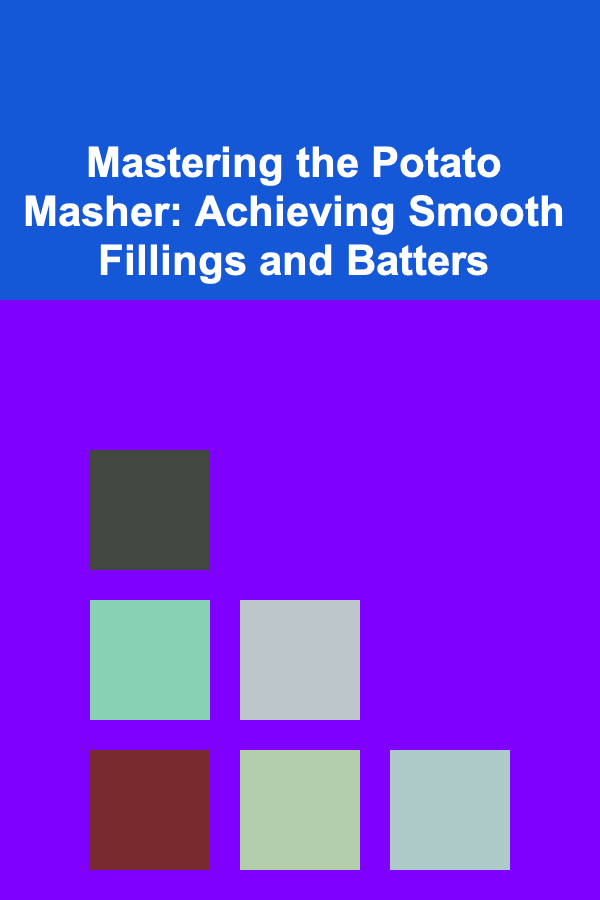
Mastering the Potato Masher: Achieving Smooth Fillings and Batters
ebook include PDF & Audio bundle (Micro Guide)
$12.99$10.99
Limited Time Offer! Order within the next:

The humble potato masher, often relegated to the task of transforming boiled potatoes into a creamy side dish, is a surprisingly versatile tool capable of far more than just mashing. While its primary function is clear, understanding the nuances of its design and application allows you to leverage its power for creating incredibly smooth fillings, lump-free batters, and even for tasks outside of traditional cooking. This article will delve deep into the art of using a potato masher, exploring its different types, techniques for achieving optimal results, and its applications beyond the simple mashed potato.
Understanding the Anatomy of a Potato Masher
Before we dive into specific techniques, it's crucial to understand the basic components of a potato masher and how they contribute to its effectiveness. While designs vary, most potato mashers share these core features:
- The Head: This is the business end of the masher, responsible for applying pressure and breaking down the food. Heads come in various shapes and materials. Some are flat and perforated with holes, others are wavy or ridged, and some feature a grid-like pattern. The material also varies, from stainless steel and nylon to wood and even silicone.
- The Handle: The handle provides leverage and control. Handles can be made of wood, plastic, or metal, and their shape and length influence comfort and efficiency. A longer handle generally provides more leverage, while a shorter handle might be easier to maneuver in smaller spaces.
- Connecting Rod: This component connects the head to the handle, transferring force from your hand to the food. The strength and rigidity of this rod are crucial for durability and preventing bending or breakage, especially when mashing dense or resistant foods.
Types of Potato Mashers and Their Ideal Uses
Not all potato mashers are created equal. The design of the head significantly impacts its performance and suitability for different tasks. Here's a breakdown of common types:
- Flat, Perforated Mashers: These are perhaps the most common type. The flat surface distributes pressure evenly, while the perforations allow the mashed food to pass through, preventing clogging and creating a smoother texture. They're excellent for potatoes, root vegetables, and cooked fruits. The size and number of perforations affect the fineness of the mash -- smaller perforations generally result in a smoother texture.
- Wavy or Ridged Mashers: These mashers feature a head with raised ridges or waves. This design is particularly effective for breaking down larger pieces of food and is well-suited for mashing potatoes with skins on or for creating rustic, chunky mashes. The ridges help to incorporate air into the mixture, resulting in a lighter texture.
- Ricers (Potato Ricers): While technically not a potato masher in the traditional sense, a ricer achieves a similar result -- a smooth, consistent texture. A ricer forces cooked food through small holes using a lever mechanism. The resulting texture is exceptionally fine and fluffy, ideal for dishes where a perfectly smooth consistency is desired, such as gnocchi or very refined mashed potatoes. Ricers are generally more laborious to use than traditional mashers, but the superior texture often justifies the effort.
- Rotary Mashers: These mashers feature a rotating blade or paddle within a container. They are designed for efficiency and can be faster than manual mashers, especially when dealing with larger quantities. However, they can be more difficult to clean and may not offer the same level of control over the final texture.
- Nylon/Silicone Mashers: These are often used in non-stick cookware. They are gentle and won't scratch the surface, but might not be as effective for mashing hard vegetables as their stainless steel counterparts.
Techniques for Achieving Smooth Fillings
Using a potato masher to create smooth fillings requires a combination of the right tool, proper preparation, and a strategic technique. Here's a step-by-step guide:
- Preparation is Key: Regardless of the filling, ensure the ingredients are cooked thoroughly. Overcooked vegetables or fruits are easier to mash into a smooth consistency. For potatoes, boiling until fork-tender is essential. For fruits like apples or berries, simmering until softened is key.
- Drain Well: Excess liquid will hinder the mashing process and result in a watery filling. Thoroughly drain cooked ingredients before transferring them to a bowl for mashing. For some fillings, like berry compotes, a small amount of liquid is desirable for moisture and flavor, so adjust the draining accordingly.
- Choose the Right Masher: For most fillings, a flat, perforated masher is the ideal choice. Its design allows for even pressure distribution and prevents clogging. If you're aiming for a rustic texture, a wavy or ridged masher can be used.
- Start Slow and Steady: Begin by gently pressing the masher down on the ingredients. Avoid applying excessive force initially, as this can cause splattering.
- Employ a Rocking Motion: Instead of simply pressing straight down, use a rocking motion. This helps to break down the ingredients more effectively and creates a smoother texture. Rotate the bowl as you mash to ensure even coverage.
- Gradual Pressure: As the ingredients soften, gradually increase the pressure. This allows you to break down any remaining lumps and achieve the desired consistency.
- Incorporate Additives: If your filling requires additions like butter, cream, or sugar, incorporate them gradually while mashing. This ensures even distribution and prevents the filling from becoming overly wet. For example, when making a potato filling for empanadas, gradually add warm milk and butter while mashing to achieve a creamy, but not runny, consistency.
- Adjust Consistency: Taste and adjust the consistency as needed. If the filling is too thick, add a small amount of liquid (e.g., milk, broth, juice). If it's too thin, continue mashing to reduce moisture or add a thickening agent (e.g., cornstarch slurry).
Specific Filling Examples and Techniques
- Potato Filling for Empanadas or Pierogi: Boil potatoes until fork-tender. Drain well and return to the pot over low heat to dry them out further. Remove from heat and mash with butter, sour cream or cream cheese, salt, pepper, and sauteed onions (optional). The key is to achieve a dry, yet creamy, consistency that won't leak out of the dough during baking or frying.
- Apple Filling for Pies or Tarts: Simmer peeled and chopped apples with sugar, spices (cinnamon, nutmeg), and a small amount of lemon juice until softened. Use a potato masher to break down some of the apples, leaving some chunks for texture. Adjust the sweetness and tartness to taste.
- Berry Filling for Crumbles or Cobblers: Combine berries (fresh or frozen) with sugar, cornstarch (for thickening), and lemon juice. Gently mash some of the berries with a potato masher to release their juices and create a jam-like consistency. Leave some berries whole for visual appeal and texture.
- Butternut Squash Filling for Ravioli or Pasta: Roast or steam butternut squash until tender. Scoop out the flesh and mash with ricotta cheese, Parmesan cheese, nutmeg, and salt and pepper. The potato masher ensures a smooth, even filling for the delicate pasta.
Achieving Lump-Free Batters with a Potato Masher
While whisks and electric mixers are often the go-to tools for creating batters, a potato masher can be surprisingly effective, especially for specific types of batters or when you're aiming for a rustic texture. The key is understanding the technique and choosing the right ingredients.
- Start with Dry Ingredients: In a large bowl, combine all the dry ingredients, such as flour, sugar, baking powder, and salt. Whisk them together thoroughly to ensure even distribution. This helps to prevent lumps from forming later.
- Gradually Add Wet Ingredients: Slowly pour the wet ingredients (e.g., milk, eggs, melted butter) into the dry ingredients. Start with a small amount of liquid and gradually increase it as you mix.
- Gentle Mashing and Folding: Using the potato masher, gently press down and fold the wet ingredients into the dry ingredients. Avoid overmixing, as this can develop the gluten in the flour and result in a tough batter. The goal is to just combine the ingredients until they are moistened.
- Focus on Lumps: Pay particular attention to any lumps that may form. Gently press the masher against the side of the bowl to break down the lumps and incorporate them into the batter.
- Adjust Consistency: Add more liquid if the batter is too thick. If it's too thin, add a small amount of flour.
When a Potato Masher Works Best for Batters
A potato masher is particularly useful for batters where a completely smooth consistency isn't necessarily desired, or when you want to avoid overmixing. Consider using a masher for:
- Pancake Batter: A slightly lumpy pancake batter can actually result in lighter, fluffier pancakes. The potato masher allows you to combine the ingredients quickly and easily without overmixing.
- Muffin Batter: Similar to pancakes, overmixing muffin batter can lead to tough muffins. A potato masher provides a gentle way to combine the ingredients and avoid developing too much gluten.
- Scone Dough: Scone dough benefits from minimal mixing. Using a potato masher to gently combine the wet and dry ingredients helps to maintain a tender crumb.
- Rustic Cornbread Batter: For cornbread, a potato masher can create a slightly coarse texture, which some prefer. It's particularly useful if you're using coarse cornmeal.
Avoiding Common Mistakes
- Overmixing: The biggest risk when using a potato masher for batters is overmixing. Remember to just combine the ingredients until they are moistened.
- Using the Wrong Masher: A flat, perforated masher is generally the best choice for batters. Avoid using a ricer, as this will result in an overly fine texture.
- Adding Cold Ingredients: Cold ingredients can hinder the mixing process and make it more difficult to achieve a smooth batter. Ensure that your wet ingredients are at room temperature before combining them with the dry ingredients.
Beyond Fillings and Batters: Unexpected Uses for Your Potato Masher
The versatility of the potato masher extends beyond its conventional applications. Here are some unexpected ways to put this handy tool to use:
- Making Guacamole: A potato masher is perfect for creating chunky guacamole. Simply combine avocados, tomatoes, onions, cilantro, lime juice, and spices in a bowl and mash to your desired consistency.
- Crushing Garlic: Place a clove of garlic on a cutting board and use the masher to crush it. This releases the garlic's flavor and makes it easier to mince.
- Muddling Herbs: Use a potato masher to gently muddle herbs like mint or basil for cocktails or sauces. Avoid over-muddling, as this can release bitter compounds.
- Making Baby Food: A potato masher is a great tool for making homemade baby food. Simply cook fruits or vegetables until tender and then mash them to a smooth consistency.
- Softening Butter: If you need softened butter quickly, place it in a bowl and use the potato masher to press and flatten it.
- Crushing Crackers or Cookies: Need crushed crackers for a topping or cookies for a crust? Place them in a zip-top bag and use the potato masher to crush them.
- Tenderizing Meat: While not as effective as a dedicated meat tenderizer, a potato masher can be used to gently pound and tenderize thinner cuts of meat.
- Breaking Up Ground Meat While Cooking: As you brown ground meat in a skillet, use the potato masher to break it up into smaller, more even pieces.
Care and Maintenance of Your Potato Masher
Proper care and maintenance will ensure that your potato masher lasts for years. Here are some tips:
- Wash Immediately After Use: Don't let food residue dry on the masher. Wash it immediately after use with warm, soapy water.
- Use a Brush: A small brush can be helpful for cleaning the perforations or ridges of the masher.
- Dry Thoroughly: Ensure the masher is completely dry before storing it. This will prevent rust and corrosion.
- Store Properly: Store the masher in a dry place, away from excessive heat or moisture.
- Avoid Abrasive Cleaners: Harsh chemicals and abrasive cleaners can damage the masher's finish. Stick to mild soap and water.
- Check for Damage: Periodically inspect the masher for any signs of damage, such as bent tines or loose handles. Repair or replace the masher if necessary.
- For Wooden Handles: Treat wooden handles periodically with mineral oil to prevent them from drying out and cracking.
Conclusion
The potato masher is more than just a one-trick pony. By understanding its design, mastering proper techniques, and exploring its diverse applications, you can unlock its full potential and elevate your culinary creations. From achieving flawlessly smooth fillings to creating lump-free batters, and even tackling unexpected kitchen tasks, the potato masher proves to be an indispensable tool in any cook's arsenal. So, dust off your masher, experiment with these techniques, and discover the transformative power of this humble kitchen essential.

How to Organize Your Seasonal Wardrobe Transition
Read More
Retail Manager's Handbook: Best Practices for Running a Profitable Store
Read More
Top Tips for DIY Home Repairs and Maintenance You Can Do Yourself
Read More
How to Collect Environmental DNA (eDNA) for Marine Life
Read More
How to Curate a Photography Portfolio for Professional Success
Read More
10 Tips for Diagnosing and Fixing Common Espresso Machine Issues
Read MoreOther Products

How to Organize Your Seasonal Wardrobe Transition
Read More
Retail Manager's Handbook: Best Practices for Running a Profitable Store
Read More
Top Tips for DIY Home Repairs and Maintenance You Can Do Yourself
Read More
How to Collect Environmental DNA (eDNA) for Marine Life
Read More
How to Curate a Photography Portfolio for Professional Success
Read More